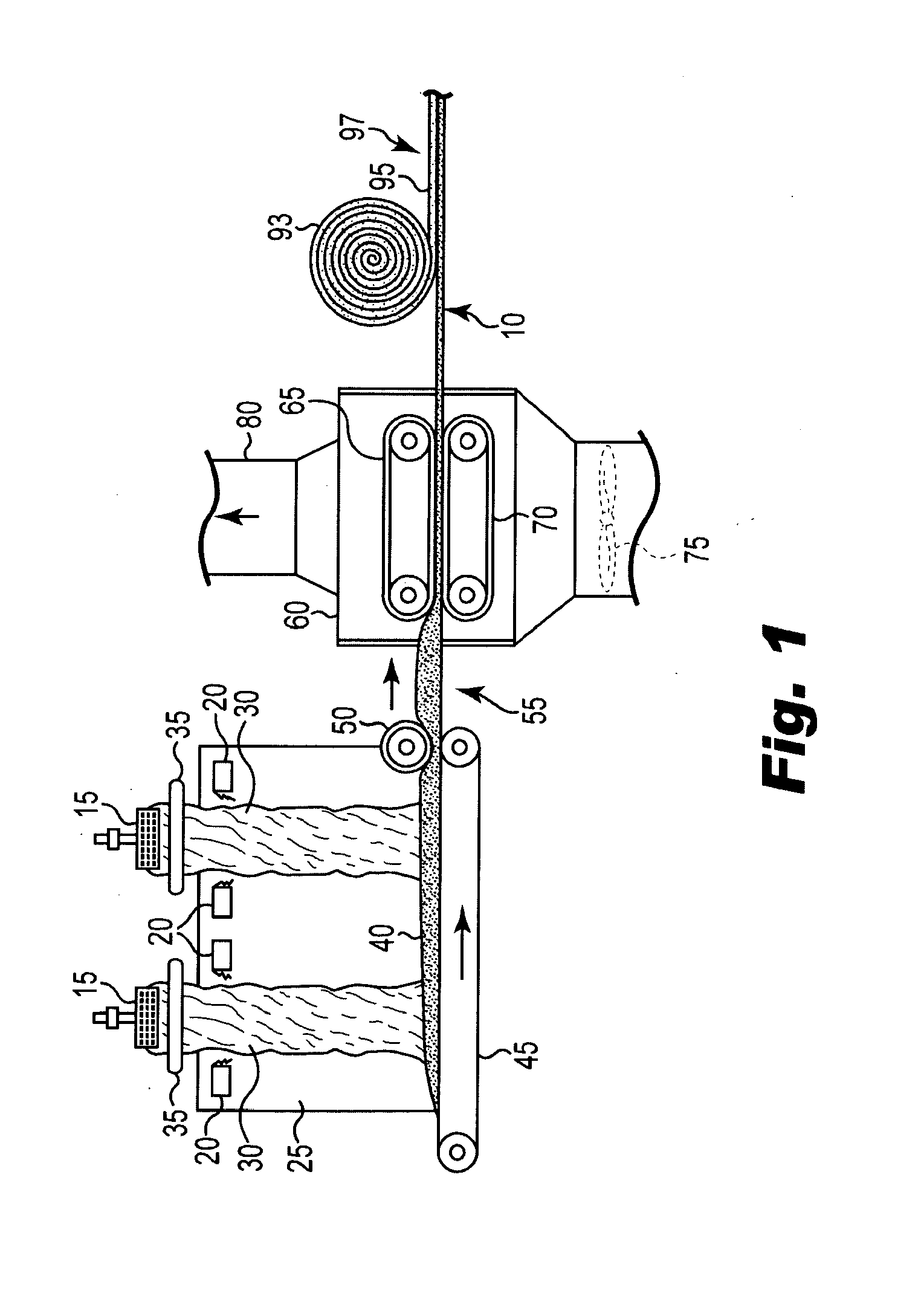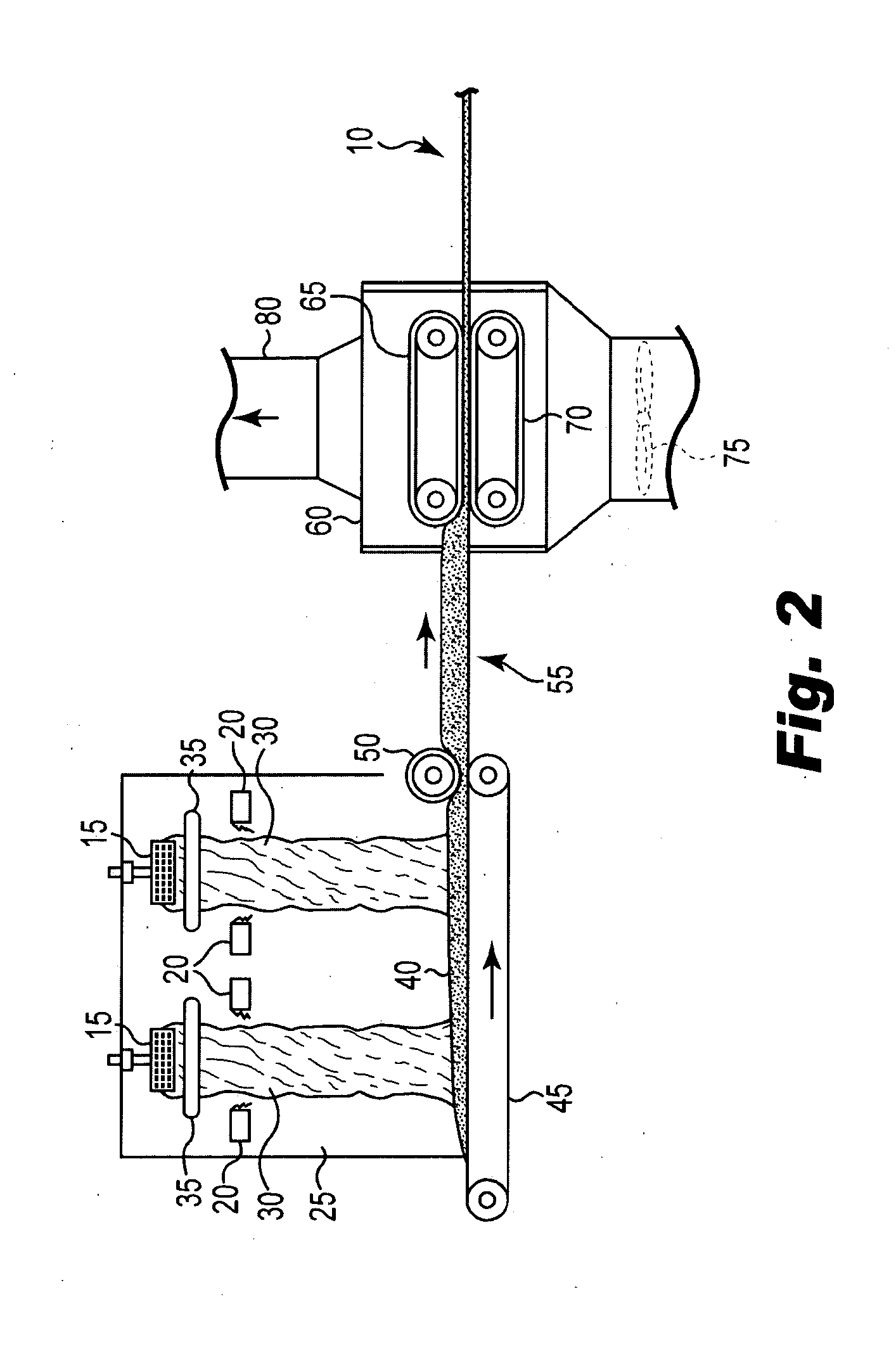Bio-based binders including carbohydrates and a pre-reacted product of an alcohol or polyol and a monomeric or polymeric polycarboxylic acid
a bio-based, binder technology, applied in the field of binders, can solve the problems of unstable urea-extended resoles, ammonia is not a particularly desirable alternative, and irritation of workers' throats and noses, so as to reduce the viscosity of the binder, speed up the crosslinking reaction, and induce faster water evaporation
- Summary
- Abstract
- Description
- Claims
- Application Information
AI Technical Summary
Benefits of technology
Problems solved by technology
Method used
Image
Examples
example 1
[0089]The effect on the ramp height of adding a pre-reacted glycerol-citric acid (GlyCA) to the binder mix is depicted in Table 3. As can be seen in Table 3, the addition of GlyCA improved ramp quality and ramp height when varying the ratios of the components without the need of additional water, which could require more water evaporation during curing (and longer curing times). It was noted that the results can vary depending on how long the glycerol-citric acid were pre-reacted (e.g., 1 h, 2 h or 3 h).
TABLE 3Ramp Height Measured While Making R-20Fiberglass Insulation Using Polyester Bio-Based BindersRampFormulationHeight (in)70:10:20 MD-CA-lyCA w / 5% SHP12.2060:10:30 MD-CA-GlyCA w / 5% SHP12.9950:20:30 MD-CA-GlyCA w / 5% SHP17.32**MD = maltodextrin, CA = citric acid, GlyCA = pre-reacted glycerol / citric acid, SHP = sodium hypophosphite
example 2
Pre-Reacted Product of Glycerol and Citric Acid
[0090]General procedure. Glycerol (USP grade) is added to a reaction vessel fitted with a temperature probe and agitator. The amount of glycerol is selected to provide a molar ratio of glycerol to citric acid of about 1.5-3:1. The glycerol is heated to a reaction temperature of about 115° C. to about 145° C. As the glycerol reaches a temperature of about 80° C., citric acid is added to the reaction vessel in small portions. The reaction is allowed to proceed for about 1.5 hours to about 24 hours. The reaction may be quenched with water or an aqueous sodium hydroxide solution if desired.
[0091]Using the general conditions above, 13 samples were prepared. The properties of these samples are provided in Table 4.
TABLE 4Glycerol:totalcitric / citrateTempRelative % ConversionGlycerol remainingExp #(molar ratio)(° C.)Other conditions(reduction of glycerol)(g gly / g product)1007-0062:113075% @ 8 hrs0.131007-0112:114075% @ 3 hrs0.131008-0022:112070%...
example 3
[0092]A pre-reacted product of glycerol and citric acid was made by heating 10 kg of glycerol combined with 10.4 kg of anhydrous citric acid in a chemical reactor at 130° C. for 1, 2, or 3 hours under ambient conditions. For most of the binder compositions, the GlyCA was dissolved in water to a 50% concentration prior to be used. FIG. 4 illustrates the rheology data obtained from the polyester bio-based binders containing a pre-reacted product of glycerol and citric acid where the glycerol and citric acid were pre-reacted for 1 h, 2 h, and 3 h, respectively, before adding the pre-reacted product to the binder composition. Additionally, a binder composition with added polyglycerol was included in FIG. 4 for comparison purposes.
PUM
| Property | Measurement | Unit |
|---|---|---|
| Fraction | aaaaa | aaaaa |
| Fraction | aaaaa | aaaaa |
| Fraction | aaaaa | aaaaa |
Abstract
Description
Claims
Application Information
 Login to View More
Login to View More - R&D
- Intellectual Property
- Life Sciences
- Materials
- Tech Scout
- Unparalleled Data Quality
- Higher Quality Content
- 60% Fewer Hallucinations
Browse by: Latest US Patents, China's latest patents, Technical Efficacy Thesaurus, Application Domain, Technology Topic, Popular Technical Reports.
© 2025 PatSnap. All rights reserved.Legal|Privacy policy|Modern Slavery Act Transparency Statement|Sitemap|About US| Contact US: help@patsnap.com



